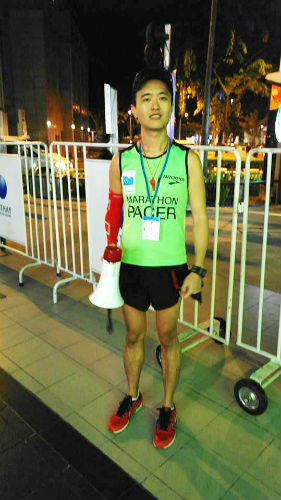You would have probably noticed the pacers and their brightly colourful balloons when you were taking part in the Standard Chartered Marathon last Sunday. You might even have followed them during the race itself and got a new personal best timing as a result of their hard work.
I caught up with the lead pacer, 31-year-old Terence Teo at the run. Terence, the head of business operations at an IT firm, explained more about pacing.
Read on for my interview with him.
Terence, how successful do you feel that the pacing operation at StanChart was?
Yeah it was a success. Our pace teams all came back right on time.
But I must say that there was a slight breach at the start because of the 45-second false start, but all of the pacers came back on time. The 5:15 and 5:30 pacers were held back by about seven minutes so they were going at net time instead of gun time. So whatever timing was reflected on the clock was not their actual finishing time.
I understand that you have been in charge of the Standard Chartered Marathon Singapore pacers for the past three years. Tell us something about your pacers.
We have a strong group of pacers who come forward to do this together and all of them are volunteers. The pacers give up 16 weeks of their time every year and put in a big effort every Saturday morning to train at East Coast Park.
How do you select the pacers?
They actually have to go through a selection procedure. There are two qualifying selection runs that they have to go through. They must also submit their past race timings to us so that we can actually see whether they fall into the timing bands that we want.
How do runners select the right pacing group for a race?
Ideally, we will give recommendations based on their training. For a marathon, if they have done a couple of training runs of more than 30km and stay at a similar range, we will look at the splits to advise them of the right group to follow. Otherwise, it will be based on their past year’s race history as well as the longest run that they have done prior to race day.
What advice would you give to runners who find that they can’t keep up with the pacers during a race?
Get a pace band from us during the race expo. Many race expos, such as this year’s Standard Chartered Marathon, have pace bands easily available for runners. The pace band is another way to help runners keep pace. But ideally, if you feel that you are unble to keep up with the group, then it is advisable to fall back and to slowly try to join the next slower group. More than often, runners make the same mistake of running too fast for their first half of the marathon. So choosing the right pace to start with, is important and my advice would be to always go for a slower pace group – unless you have trained hard and know the pace that you are following.
If a runner wants to become a pacer, what advice would you give him or her?
Be ready to commit and give back to the community. Pacing is not for fame or glory. It’s all about giving back and helping others. Come with the right mindset and you will enjoy the experience. Come with the wrong mindset and you may just find yourself having too much expectations.




Leave a Comment